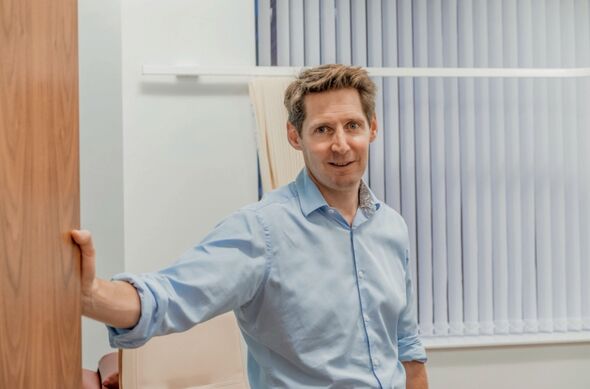Former
President Joe Biden
recently underwent a procedure to excise skin cancer lesions, his spokesperson revealed on Thursday, marking another
health hurdle for Biden
.
Spokesperson Kelly Scully confirmed the surgical intervention following the release of footage by Inside Edition showing Biden with a noticeable scar on his forehead after attending church in Delaware. Scully explained that Biden underwent Mohs surgery, a specialized technique aimed at
removing layers of skin
until all cancerous cells are eliminated.
The Express US reached out to a
number of skin cancer specialists
to understand the former president’s condition. Dr. Maral Kibarian Skelsey, Director of the Dermatologic Surgery Center of Washington, says that a cancer “on the face” is one of the most high-risk areas, and adds that Biden may even develop another skin cancer later.
-
Trump explains why White House windows cannot be opened
-
Trump explodes with furious warning to Xi and Putin
“He does have an increased risk of getting a second skin cancer. Most of these, but not all of them, are caused by Ultraviolet light, as many cancers are related to ultraviolet light, as well as personal or family history. So once you have had enough UV exposure to get a skin one skin cancer, you’re highly likely to get a second one,” Skelsey adds.
This is actually Biden’s second tango with the Mohs procedure, the most common and safe way to remove skin cancer cells. Two years prior, during his presidency, Biden had a chest lesion removed, which was identified as basal cell carcinoma, a widespread type of skin cancer.

Biden’s team did not specify what kind of cancer the former leader was treated for, or when he had the surgery.
“For regular skin cancer, and people who are at higher risk than those with a personal or family history of skin cancer, self-exams are very important because half of melanomas are self-detected,” warns the doctor, as she adds that skin cancer is the most common form of the disease, with one in five Americans recieving a diagnosis at some point in their lives. In fact, just days ago world famous TV chef Gordon Ramsey shared a similar diagnosis and procedure.
Biden had the best treatment – Mohs surgery
Dr. Paul Farrant, Consultant Dermatologist FRCP for Experts in Skin and Hair, explains that Mohs surgeries are the absolute top treatment for most such diagnoses. “Mohs surgery is a precise and effective treatment for common types of skin cancer, such as basal cell carcinoma,” he explains.
The technique, which has been around since the 1930s, involves removing the cancer layer by layer while examining each layer under a microscope until no cancer cells remain. This ensures the tumour is fully removed while sparing as much healthy tissue as possible – which is especially important on visible areas like the face.
Mohs surgery is performed with just local anesthetic, which is safer for older patients like the former President. After the tumor has been removed, the wound is generally reconstructed, meaning closed with stitches. Sometimes, the wound is allowed to heal on its own,
“Mohs surgery gives patients the best chance of curing skin cancer while keeping scarring to a minimum. For someone like President Joe Biden, it also means a faster recovery and peace of mind that the cancer has been dealt with properly,” Farrant assures.

Dr. Farrant also disagrees with Dr. Skelsky, arguing that the Mohs procedure should remove further risk. “It is almost certainly cured, e.g., 99% will be cured, and there is a very, very low chance of it coming back. If it does, it will be where the original lesion was. It will not spread inside or affect general health,” Dr. Farrant adds.
Richard Krathen, founder of Florida Dermatology Specialists, says that Biden’s recovery should be easy and go well, as the surgery has been developed to cause the least amount of damage. “After Mohs surgery, there may be some temporary swelling, bruising, and possibly some discomfort, usually easily managed with over-the-counter pain relievers like acetaminophen (Tylenol) or ibuprofen (Advil or Motrin),” Krathen explains.
Biden’s past cancer diagnosis
In May, an announcement from Biden’s office disclosed his diagnosis with an advanced form of prostate cancer that had metastasized to his bones. However, Dr. Farrant says that his previous diagnosis may not have much to do with his current one. “No. There is no link with prostate cancer and BCC except age, cancers generally get more common as we live longer, prostate is common in older men, and Basel Cell Carcinomas are very common in both sexes as we get older, depending on skin type and sun exposure.”
“Cancer touches us all,” Biden shared on social media then. “Like so many of you, Jill and I have learned that we are strongest in the broken places.”
The Biden family has been no stranger to cancer battles; Biden’s son Beau succumbed to a brain tumor, and his wife, Jill, has undergone the removal of two cancerous lesions.

Avoiding Skin Cancer
All of the doctors interviewed agree, though, that Biden’s scare should put the public on edge about their own health. “When I see someone like President Biden with a history of skin cancer, I’m reminded how common these cancers are, especially in people with lighter skin and years of sun exposure,” says Dr. Hannah Kopelman, a board-certified dermatologist at
DermOnDemand
.
“The encouraging part is that when we catch them early and treat with Mohs, patients do extremely well. That’s why I emphasize regular skin checks with all of my patients. It’s the most important step we can take to protect their long-term health,” Kopelman stresses.
“Early prevention involves checking for new or changing spots, and using sunscreen and reapplying it. It also involves avoiding tanning beds,” adds Dr. Maral Kibarian Skelsey.
Skelsey adds, “The number one preventable cause of skin cancer is ultraviolet light exposure or the sun. So, preventing skin cancer is possible by limiting sun exposure and avoiding indoor tanning.”
Skelsey listed the best ways to prevent a similar diagnosis as Biden: “seek shade, remember that the skin rays are strongest between 10 and 2, and do things in the shade wearing some protective clothing, such as long sleeves and shirts rated for UV protection, a hat, sunglasses, long sleeves, using a broad-spectrum water-resistant sunscreen with an SPF of at least 30. You need to use about an ounce for an adult, and it needs to be used even on a cloudy day and reapplied after swimming or sweating.”
The doctor says exposure to damaging rays when one is by the water, snow, or sand increases because they are reflected.
“I really avoid tanning. I mean, indoor tanning is important, and if you really want to get a tan, self-tanner is a great way to do it. If you have something new, changing, or unusual, something that doesn’t look like the rest,” Skelsey recommends seeing a board-certified dermatologist that’s recommended by the AADA. ” It’s important because it’s a highly curable kind of cancer, but the important thing is early detection.”
